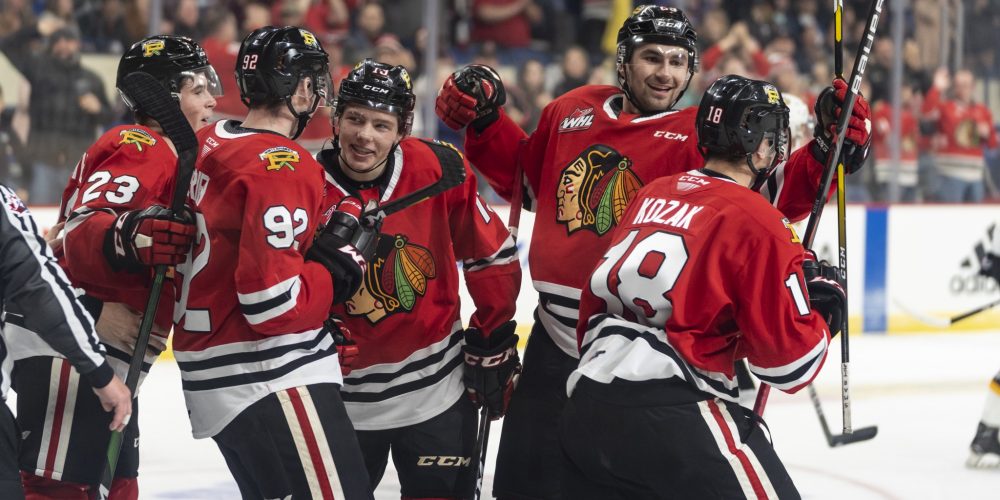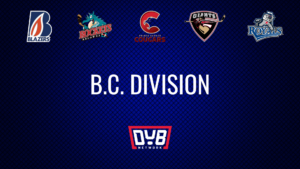The Portland Winterhawks’ 68-game schedule is three-fourths complete, and I’ve taken a glance at the numbers to spot anything which catches my eye.
For this report, I only included active roster skaters. Any players no longer on the team, whether by trade, release, or any other reason, are not included.
Dante Giannuzzi, and Joel Hofer are not included in the offensive numbers but rather have their own section.
16’s – O’Brien, Klassen, Stefan
17’s – Fromm-Delorme, Hanas, Jarvis, Knak, Kozak, Smythe
18’s – Brøndberg, Dureau, Gervais, Hanus, Newkirk, Nolan
19’s – Cicek, Ludvig, Mannek
20’s – Gilliss, Gricius, Quigley
A first glance at the main statistics broken down by age:


Goals:
As of February 9, Portland is second in the league with 215 goals scored. Only the Medicine Hat Tigers (220) have found the back of the net more.
When I reviewed the first half of the season, the Winterhawks were on track to score 254 goals this season. Now, after 51 games, if Portland were to keep the same pace, the total at season’s end would be 286. This is an increase of 28 goals compared to last year’s team and the most goals scored since 2014-2015 when the team scored 287.
Through the first 17 games, Portland was averaging 3.58 goals per game. The second quarter jumped to 3.73, but an impressive third quarter boosted their numbers yet again. With 17 games to play in 2019-2020, the Winterhawks are averaging 4.21 goals per game.
Seven different players have double-digit goals and four more skaters are one away from reaching the milestone.
It has been a talking point all season, but Portland’s balanced scoring, and production from all four lines, is impressive.
Showcasing the depth of Portland’s scoring, Seth Jarvis leads the Winterhawks with 30 goals. Seth’s 30 goals accounts for 14.2% of the total. For comparison, the WHL’s leading scorer, Adam Beckman of the Spokane Chiefs, has scored 19.7% of his team’s goals. Jarvis doesn’t rank in the top five across the WHL in that category.

As of February 9, Jarvis sits seventh in the WHL in goals scored. The next highest 2002-born skater is Connor McClennon, ranked 27th with 21 goals on the year.
15 of his 30 goals have come since the calendar flipped to 2020. Jarvis played in 15 of the Winterhawks’ 17 games — missing two games to attend the CHL/NHL Top Prospects Game. The Winnipeg, Manitoba, native scored in eight of the contests. When Jarvis scores, he often scores multiple times.
During this latest stretch, he has six multi-goal games including one hat trick.
The 2020 NHL Draft prospect increased his goals per game from a respectable 0.48 after the midpoint of the season to 0.65, which is astonishing for a 17-year-old player.
In Portland’s last game against Kelowna, Reece Newkirk reached the 25 goal milestone for the first time in his WHL career.
The Moose Jaw, Saskatachewan, native ranks 14th in the WHL and is consistently finding the back of the net. Newkirk only has two games with multiple goals; however, his longest goal drought came at the start of the season. His first goal came seven games into the season, but since then, he hasn’t gone over three games without lighting the lamp.
When Newkirk scores a goal, Portland is 19-3-1-0.
The New York Islanders prospect has steadily increased his goals per game in each quarter of the season — Q1: 0.29, Q2: 0.44, Q3: 0.51.

No player has increased his goal scoring more than Jaydon Dureau.
In my mid-season report, he was my player to watch in the second half, and sure enough, the 18-year-old found that next level in his offensive game.
At the midway mark of the season, he was shooting 7.3%. Given Jaydon finished his 17-year-old season at 14.4%, this seemed unsustainable or unlucky depending on how you view statistics.
How much of an improvement has the White City, Saskatachewan, native made?
His 15 goals on 110 shots now has his shooting percentage at 13.6%. Dureau’s goals per game after 34 games was 0.13 and now rests comfortably at 0.31, a jump of 138%.
Should he keep on the same goals-per-game pace, the five-foot-eleven, 174-pound winger will finish the season as a 20-goal scorer.
More on this later, but Dureau’s increase in goal production has not impacted his ability to continue to be a setup guy.
Led mainly by Jarvis, with help by Cross Hanas, the 17-year-olds continue to be the leading age group in regards to scoring. Portland’s 2002-born skaters have registered 34.4% of the team’s goals while the 18-year-olds are about 5% behind. Both age groups have six skaters each.
Portland’s 16-year-old rookies have combined for 21 goals (Jack O’Brien – 9, Gabe Klassen – 7, James Stefan – 5) which is 10% of the team’s total. The veterans on the team combine for 26.4% with the three 2000-born skaters at 12.7% and the three overagers with 13.7%.
Klassen’s strong rookie season continues after not starting the year with the Winterhawks. While not playing every game due to being included in the forward rotation, his goals-per-game rate has remained steady at 0.32 (0.31 at the halfway mark of the season).
Johnny Ludvig continues to provide scoring from the blue line. His 16 goals in 2019-2020 has him third in the WHL for goals by a defenseman. Only Alex Cotton of Lethbridge and Jake Christiansen of Everett have more — both have 17.

The Kamloops, British Columbia, native has half of his goals at even strength while the other eight have come on the power play. When their captain scores, the Winterhawks are 11-2-1-2.
Seven of the 19-year-old’s goals have come in the first period, four in the middle frame, and five in the game’s final 20 minutes.
Ludvig needs four more goals, currently on pace for five, to reach the 20-goal mark.
If he does, how impressive would the accomplishment be?
Per Andy Kemper, Winterhawks team historian, only twice since the 1992-1993 season has a Portland defenseman scored 20 goals in a season. Brandon Smith hit the milestone that season and Troy Rutkowski was the latest to do so in 2012-2013.
In team history, only five Winterhawks defensemen have scored 20 — Jeff Sharples (25) in 1986-1987, Jim Benning (28) 1980-1981, and Dave Babych did it twice. He scored 22 in 1979-1980 and 20 in 1978-1979. (Stats provided by Kemper)

Cross Hanas continues to find the back of the net in his NHL Draft-eligible season. The 17-year-old from Texas has more than doubled his production from his rookie season. Last year, Cross scored eight goals in 67 games. In 48 games so far, the six-foot-one, 164-pound forward has 17 goals. His shooting percentage continues to be one of the highest on the team. As of February 9, he found the back of the net on 16.3% of his shots.
Game-winning goals continue to be scored by committee. Jarvis has pulled away slightly and leads the team with six; however, 12 different Winterhawks have scored the eventual game-deciding goal.
Lane Gilliss has 11 goals in 2019-2020, four of which were the game-winning variety. When the overage forward finds the back of the net, Portland has won ten games and has not lost in regulation.
Newkirk is tied with Gilliss for second on the team. Robbie Fromm-Delorme and Jaydon Dureau are one behind them. Meanwhile, Jake Gricius, Simon Knak, Cross Hanas, Clay Hanus, and Jonas Brøndberg all have scored a pair of game winners.
Assists:
Two assists can be awarded on every scoring play. Therefore, a total of 424 possible assists are available on Portland’s 212 goals (three goals are added for shootout wins). With three quarters of the season completed, Portland has 375 assists across all players, good for 88.4% of the available amount.
After 25% of the season, the 17- and 18-year-olds were tied at 37 assists each. The 2002s held a slight edge 70-65 after 34 games. The gap has increased to 127-107 with a quarter of the schedule remaining. The other three age groups saw a negligible change in their share of assists. (See above tables for specific numbers.)
15 different Winterhawks have double-digit assists and two more sit at nine.

The run Jarvis went on in January was remarkable — he was named WHL Player of the Month. Midway through the season Newkirk held a 26-20 lead in assists over Jarvis. Not only did Jarvis pass him, the 17-year-old now leads Reece 42-34.
Jarvis went from 0.65 assists per game to a noteworthy 0.91, an increase of 40%.
While Newkirk’s assist production dropped from 0.81 per game to 0.69, his points per game only dropped by 0.05 (his goal scoring increased).
With 34 assists in his first season after being drafted by the New York Islanders, Newkirk is only two shy of his total from last season. 20 of his 34 assists are primary, a slight increase since my last report (53.8% to 58.8%). The Moose Jaw, Saskatchewan, native continues to distribute the puck to a variety of skaters. 11 different Winterhawks have scored a goal assisted by Newkirk.
Jake Gricius has already established a new career high in assists with 36. Last year was his previous best when he finished the season with 34 apples. If the Colorado Springs, Colorado, native keeps his current pace, he will finish his final season in the WHL with 48. Jake has two more secondary assists than primary, which remained consistent over the last two quarters.
As previously mentioned, with Dureau finding the back of the net more often, his setup ability has not suffered as a result. The 18-year-old is still producing 0.7 assists per game — right where he was after game 34. With his 36 assists this season, Dureau is tied with Gricius and Ludvig for second on the team.

After interviewing Dureau and Jarvis throughout the season, both have talked about the chemistry they have with one another. They play with speed and know where the other is going to be on the ice. Not only has the duo spent most of this season on the same line, but Mike Johnston paired them together last season as well.
Dureau has assisted on 16 (ten primary) of Jarvis’ goals. Of Jaydon’s 15 goals, Seth picked up an assist on 11 of them.
On each other’s last ten goals, Jarvis has been in on nine while Dureau assisted on seven.
One of the benefactors of the pairing is rookie center Jack O’Brien. Five of his nine goals have been assisted by both Jarvis and Dureau. The 16-year-old has not looked out of place when playing on perhaps Portland’s top line.
In the last 17 games, Cross Hanas picked up 12 assists, surpassing his 14 from a year ago. Only five of his assists have come via the power play, so the young Texan is producing five-on-five. Between home and the road, Cross has slightly more assists away from the Rose City (12-10).
Simon Knak rejoined the team after representing Switzerland in the World Juniors. Having missed 13 games so far this year, the first-year import again increased his assists per game. In Q3, his assists rose to 22 for the year, a 20% increase per game.

Second-year winger Robbie Fromm-Delorme continues to be a primary assist machine. Only 6 of the six-foot-one, 177-pounder’s 23 assists have been secondary. Also, the Richmond, British Columbia, native has 43% of his assists in the third period or overtime. When Fromm-Delorme picks up a primary assist, the Winterhawks have a record of 11-0-0-1. Jake Gricius has been on the scoring end of a Fromm-Delorme pass six times this season. Despite missing 18 games this season, Robbie has already crushed his rookie season statistically, increasing his assists from 11 to 23. On his current pace, Fromm-Delorme will finish the year with 32.
From the blue line, Ludvig’s 36 assists leads the group coached by Kyle Gustafson. Clay Hanus currently sits in second with 12 apples; however, four of the rearguards are within three. Matthew Quigley (11), Jonas Brøndberg (10), Kade Nolan (9), and Nick Cicek (9) are all bunched up behind.
Plus/Minus:
Most are familiar with this statistic, but to be clear, players earn a “plus” if they are on the ice when their team scores a goal at even strength or shorthanded. Players receive a “minus” if they are on the ice for a goal against at even strength or when a shorthanded goal is scored by their opponent. Being on the ice for a power-play goal for or against doesn’t impact a player’s plus/minus rating.
Given how many variables factor into this statistic, many in the hockey community feel it isn’t the best representation of a player. They could just be jumping on or off the bench when a goal is scored, meaning they have no involvement in the goal. The player could also not be responsible for either the breakdown on defense or the zone time on an offensive shift.
That said, until a better one is provided and available, I will continue to review this statistic.

Every age group has increased its collective rating by a minimum of 13. The 16-year-olds had a rating of 13 after the mid-year review, but are now 26. The 2001s and 2002s each have six players, and they raised their ratings by 39 and 37 respectively. The three 19-year-olds showed a solid improvement, going from 47 to 68 — a gain of 21. Finally, the overagers had a respectable 18 rise in their rating.
Ludvig continues to lead the team with a +42 rating which is also good enough to tie him for the league lead as of February 9. A third-round pick in the 2019 NHL Draft, Ludvig increased his rating by 17 points in the third quarter of the season.
Jarvis took over second on the team with an increase from a +12 to +31 rating. His increase by 19 led the team during the third quarter. Dureau was right behind him with an improvement of 18 (3 to 21).
Matthew Quigley is a big contributor to the overagers’ increase in rating. Hailing from Chestermere, Alberta, the 20-year-old saw his +15 climb to +26.
Hanus saw the biggest jump per quarter in his WHL career, going from +2 to +12.
For the second quarter in a row, Tyson Kozak (+21) raised his rating by nine.
Power Play Statistics:
Upon the conclusion of games on Sunday, February 9, Portland’s power play ranked fifth in the Western Hockey League at 24.1%. While remaining static in fifth, the Winterhawks power play increased by 1% overall in the third quarter.
The Winterhawks have converted on 48 of their 199 man-advantage opportunities.
Last season, Portland finished sixth in the WHL with a 23.2% success rate, so they are on pace to beat last year’s numbers.

Only four times during the third quarter of the season did the Winterhawks fail to score a power-play goal. Prior to their last game in Kelowna, Portland had gone seven straight games with a goal while on the man advantage. Also, in four games, the Winterhawks scored a pair of power-play goals.
11 different Winterhawks have a power-play goal.
Kyle Gustafson has mixed up the looks as well as the zone entries of late, keeping penalty killers on their toes.
For example, after 34 games, Jarvis’ six man-advantage goals were good enough to lead the team. However, Newkirk scored seven in the last 17 games, allowing him to blow by Jarvis for the team lead at 12. While Newkirk has been lighting the lamp, it doesn’t mean Jarvis has not been involved on the power play. Instead, he has turned into more of a distributor. Seth posted eight power-play assists — five of which were secondary — in the third quarter.
With eight tallies on the man advantage, Ludvig and Jarvis are second on the team.

So far through 51 games, when Portland’s second unit has success, Lane Gilliss is usually the catalyst. His six goals on the man advantage are by far the most of any player not on the top unit. Over 50% of his goals this year have come on the power play.
Ludvig took over the team lead in power-play assists from Dureau as the 19-year-old has set up 16 goals.
16 different skaters have tallied at least one power-play assist in 2019-2020.
Penalty Kill and Shorthanded Goals:
Upon the conclusion of games on Sunday, February 9, Portland’s penalty kill ranked second in the Western Hockey League at 86.7%, allowing only 26 power-play goals on 196 opportunities.
At the halfway mark of the season, Portland’s penalty kill was first but has fallen behind Edmonton for the top spot. A slight decrease from 87.5% success rate, along with Edmonton’s rise to 87.8%, contributed to that ranking.
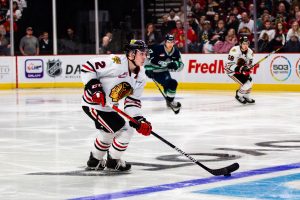
With 34 games left in the season, Portland was 11th in the total number of times shorthanded per game at 4.24. Now, with 17 games still on its schedule, Portland rests in 12th. The team did however reduce the number of penalties per game by 0.40 to 3.84.
The Winterhawks’ discipline is improving as the season progresses and will obviously continue to be an area of focus as the games get tighter.
When they have taken penalties though, Don Hay’s group has done a tremendous job killing them off. Portland has improved each quarter with respect to the number of games allowing a power-play goal. In Q1, their opponents scored on the man advantage in eight games, seven times in Q2, and only 6-of-17 games in Q3.
Only once in the quarter did the Winterhawks allow more than one power-play goal in a game (three in Victoria on January 11).
Portland’s best performance in the quarter on the PK came in Spokane on January 17 when the Chiefs failed to score on seven power play chances.
Portland’s seven shorthanded goals puts them fifth in the league.
Only Jake Gricius has more than one marker when down a man. His second came on a beautiful shot between his legs against Everett.
Jarvis, Newkirk, Dureau, Mannek, and Cicek each have one shorthanded goal.
Goaltending:
Joel Hofer’s first half performance was good enough to earn him a spot on Canada’s roster for the 2020 World Juniors. Not only did Hofer make the team, but he left the tournament with a gold medal and the award for the tournament’s best goaltender.
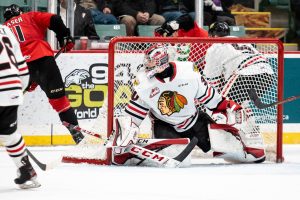
Since returning, however, his numbers have not continued from his impressive first half. The Winnipeg, Manitoba, native started 12 of the 17 games in the third quarter. During this time, he stopped 320-of-362 shots — a save percentage of 0.884. His goals-against average since rejoining the Winterhawks is 3.53.
On Saturday, February 8, Hofer looked back to his usual self and stopped 36-of-38 against the Kelowna Rockets.
One area which can prove challenging for goaltenders is going long stretches without facing any shots. Over Hofer’s 12 starts, Portland outshot its opponents by 157 (519-362) — an average of 13 per game.
Portland has three straight three-in-three weekends coming up. If Portland wants to maintain its lead over Everett in the U.S. Division, Hofer will need to have more performances like Saturday and fewer of the three or four goals on 19-23 shots. That said, not all the goals have been Hofer’s responsibility — there have been several defensive lapses in front of him.
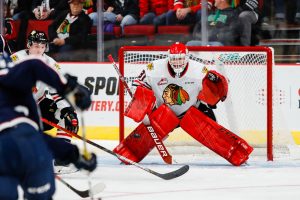
Dante Giannuzzi started three times during the last run of 17 games. The 17-year-old also made one relief appearance to start the third period against Tri-City in a blowout victory.
Also from Winnipeg, Giannuzzi has been impressive when called upon. The 2002-born netminder stopped 75-of-80 shots for a save percentage of 0.938 in the third quarter of the season.
Included was his first WHL shutout which came against the Kelowna Rockets at the Veterans Memorial Coliseum. Dante stopped all 17 shots he faced and is a perfect 5-0 in 2019-2020.
Portland has provided Giannuzzi with 18 goals of offensive support in his three starts.
Given the upcoming grueling schedule, Giannuzzi could see his first start since his shutout back on January 18. Hofer has started the last six games for the Winterhawks.
The other two starts in the third quarter went to Isaiah DiLaura who was traded to the Swift Current Broncos a few days before the trade deadline.
Down the home stretch:
With 17 games remaining, Portland is already locked into the playoffs. Even though they were the first WHL team to officially clinch a playoff spot, the Winterhawks have their eyes on a much bigger prize.
Sure, hanging a U.S. Division Championship banner is a nice accomplishment, but having home-ice advantage throughout the playoffs is more important.
As of February 9, Portland is two points ahead of the Edmonton Oil Kings with a game in hand.
With the Kamloops Blazers in a mini slump currently, the lead for the top seed in the Western Conference is nine points over the Everett Silvertips. Everett does have one game in hand with 18 games remaining.

Should the playoffs start today, Portland’s first-round opponent would be the Seattle Thunderbirds. The race for the two wild card spots is most likely going to come down to the T-Birds and the Rockets. Vancouver is six points clear for third in the B.C. Division and Seattle is nine points ahead of Prince George for the second wild card position.
With both teams having played 51 games, Kelowna is one point ahead of Seattle for the first wild card.
I imagine the WHL is licking its chops at how the Western Conference matchups would be set if the playoffs started today — Portland-Seattle, Everett-Spokane, Kamloops-Kelowna, and Victoria-Vancouver.
A lot can change over the course of the next month and a half though.
Portland’s schedule is filled with U.S. Division games to finish off the season. 14-of-17 games will be played against teams from Washington.
On Sunday, the Moose Jaw Warriors come to town for the only meeting between the two teams. The Winterhawks will go a perfect 6-0 versus the East Division if they emerge victorious against the 27-point Warriors.
The other two non-divisional games are against the Victoria Royals and former goaltender Shane Farkas. Portland and Victoria each won an overtime game when the teams met on the island last month.
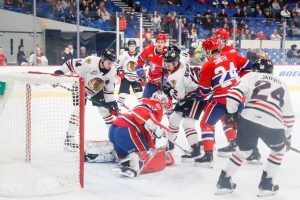
Games against the division are often treated like four-point games. The Winterhawks have done well so far against the teams they see most often.
In 22 U.S. Division games, Portland is 16-1-2-3.
The Winterhawks will see Seattle five more times before the conclusion of the season on March 22. Record: 4-0-0-3
The race for the top spot against Everett may come down to the four head-to-head meetings still left on the docket. Record: 3-1-0-0
Portland still travels out to Kennewick twice to face Tri-City while the Americans visit the VMC for the last time on March 4. Record: 5-0-0-0
The Winterhawks only see their first-round playoff opponent the last two seasons — Spokane Chiefs — twice over the last 17 games. Record: 4-0-2-0
I will provide one more update once the regular season concludes on March 22.

